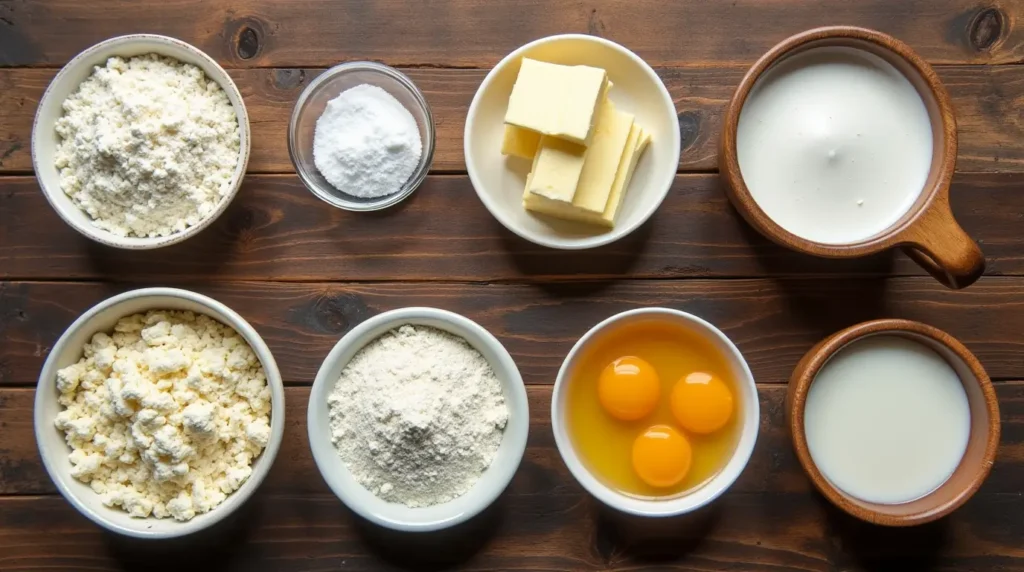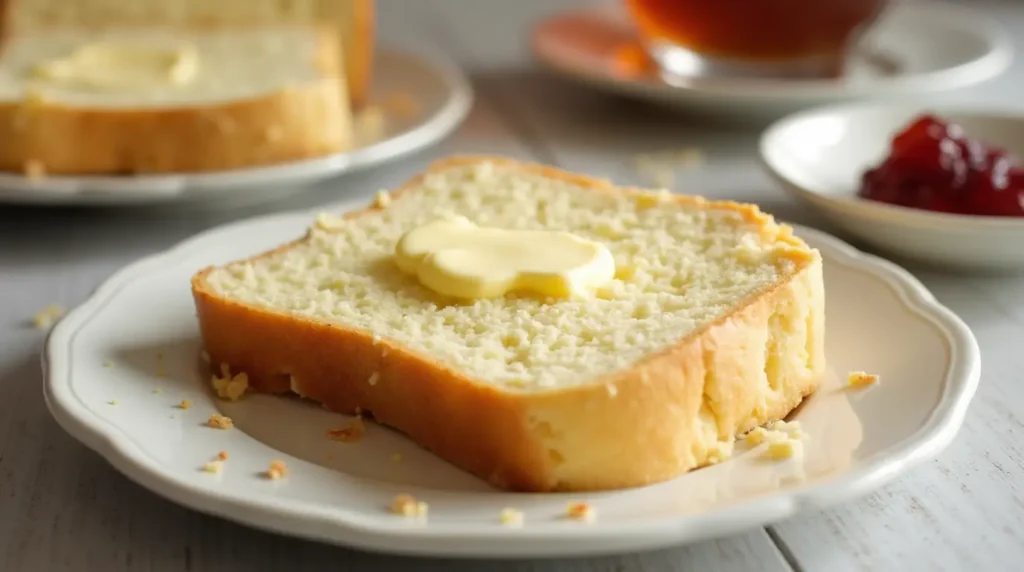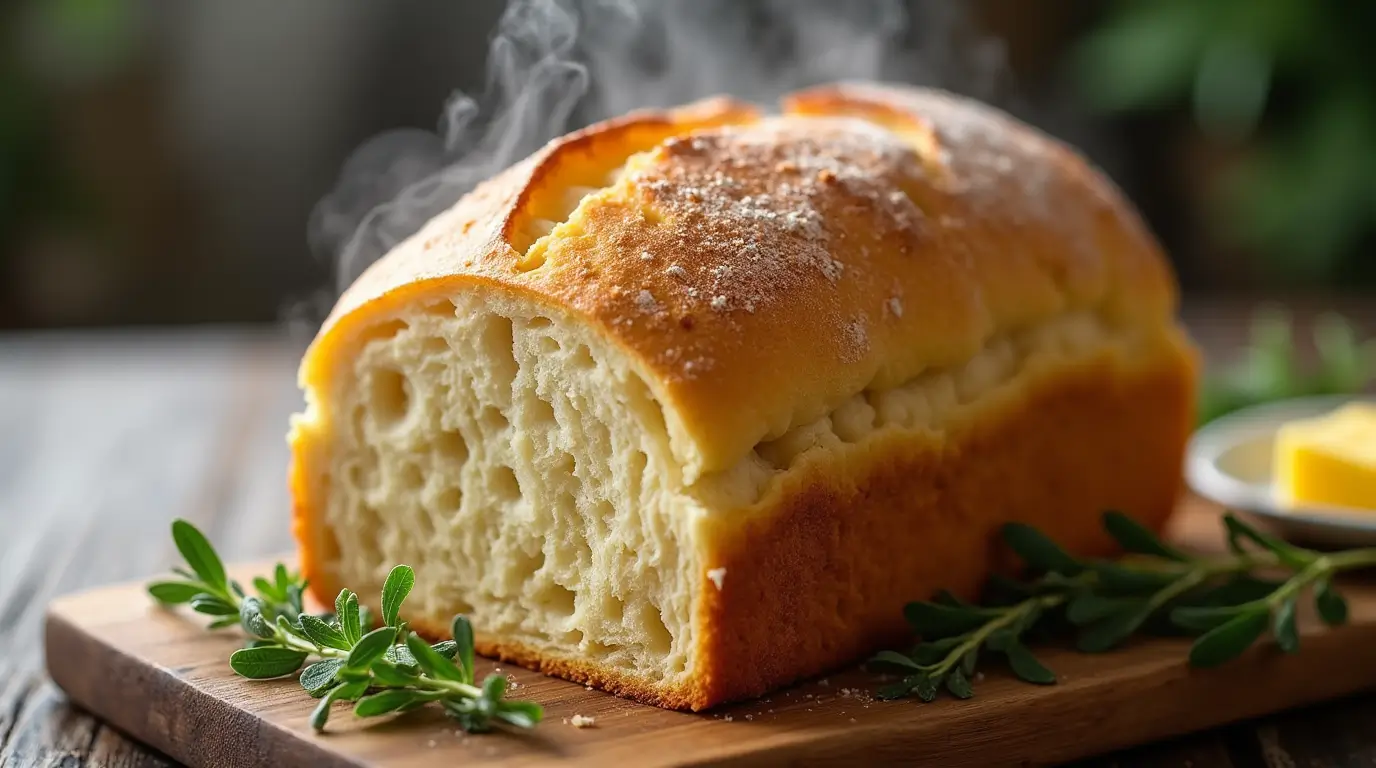This Cottage Cheese Bread recipe is your ticket to golden, fluffy, and slightly tangy bread that’s perfect for every occasion. Whether you’re an experienced baker or trying bread-making for the first time, this recipe combines simplicity with flavor. From breakfast toast to a dinner side dish, this bread will elevate your meals while bringing warmth to your kitchen.
Introduction
If you’ve ever wondered what gives homemade bread that irresistible balance of softness and structure, this Cottage Cheese Bread will satisfy your curiosity. It’s not just a bread recipe; it’s a journey to achieving the perfect loaf that’s tangy, moist, and rich in texture, thanks to the magic of cottage cheese.
This recipe holds a special place in my kitchen, not just for its taste but for its versatility. Perfect for sandwiches, dipped in soup, or even served with a dollop of butter and jam, Cottage Cheese Bread is a must-have in your baking repertoire. Plus, it’s beginner-friendly! Even if you’ve never baked before, this guide will lead you step-by-step to bread-baking success.
Table of Contents
Key Takeaways
- Taste: This bread features a subtle tang from cottage cheese and a light sweetness, balanced by its fluffy crumb.
- Dietary Considerations: Vegetarian-friendly and rich in protein, it’s a wholesome choice for everyone.
- Versatility: It’s perfect for breakfast, a snack, or as an accompaniment to any meal.
- Ease of Preparation: Simple ingredients and clear instructions make this recipe approachable for all skill levels.
Recipe Card
| Prep Time | Cook Time | Total Time | Servings | Calories per Serving |
|---|---|---|---|---|
| 15 minutes | 40 minutes | 2 hours | 10 slices | 220 kcal |
Ingredients
| Ingredient | Quantity | Notes |
|---|---|---|
| All-purpose flour | 3 cups | Can substitute bread flour for a chewier texture |
| Cottage cheese | 1 cup | Full-fat or low-fat works |
| Sugar | 2 tbsp | Adds a touch of sweetness |
| Salt | 1 ½ tsp | Enhances flavor |
| Baking powder | 1 ½ tsp | Provides rise |
| Baking soda | ½ tsp | Reacts with the acidity of cottage cheese |
| Butter, melted | 2 tbsp | Adds richness |
| Eggs | 2 large | For binding and structure |
| Milk | ½ cup | Adjust consistency, if needed |

Step-by-Step Recipe Instructions for Cottage Cheese Bread
Step 1: Prepare the Ingredients
Begin by preheating your oven to 350°F (175°C). Lightly grease a standard loaf pan or line it with parchment paper for easy removal. Gather all your ingredients and measure them accurately.
Tip: Use room-temperature eggs and cottage cheese to ensure even mixing.
Step 2: Mix the Dry Ingredients
In a large mixing bowl, whisk together the all-purpose flour, sugar, salt, baking powder, and baking soda. Use a whisk to evenly distribute the leavening agents throughout the mixture.
Tip: Sifting the dry ingredients can prevent lumps and make the bread lighter.
Step 3: Incorporate the Wet Ingredients
In a separate bowl, whisk together the cottage cheese, melted butter, eggs, and milk until smooth. Slowly pour the wet mixture into the dry ingredients, gently stirring until a soft, cohesive dough begins to form.
Tip: Avoid overmixing the dough to prevent a dense texture in the final loaf.
Step 4: Transfer and Shape
Pour the dough into the prepared loaf pan, spreading it evenly with a spatula. Smooth the top and give the pan a gentle shake to remove air bubbles.
Tip: For an extra golden crust, brush the top with: melted butter before baking.
Step 5: Bake to Perfection
Place the loaf pan in the center of the oven and bake for 40–45 minutes, or until the top is golden brown and a toothpick inserted into the center comes out clean.
Tip: Keep an eye on the bread after the 35-minute mark to prevent over-browning.
Step 6: Cool and Serve
Allow the bread to cool in the pan for 10 minutes before transferring it to a wire rack to cool completely. Slice and serve as desired.
Tip: Store leftovers in an airtight container at room temperature for up to 3 days.
Notes
- To make a gluten-free version, replace the all-purpose flour with a gluten-free flour blend.
- Add-ins like chopped herbs, shredded cheese, or garlic powder can enhance flavor.
- If you prefer a denser loaf, reduce the baking powder slightly.
Nutrition Information
| Nutrient | Amount per Serving |
|---|---|
| Calories | 220 kcal |
| Total Fat | 8 g |
| Saturated Fat | 4 g |
| Cholesterol | 50 mg |
| Sodium | 400 mg |
| Total Carbohydrates | 27 g |
| Dietary Fiber | 1 g |
| Sugars | 3 g |
| Protein | 7 g |
Tools and Equipment Needed
| Equipment | Purpose |
|---|---|
| Mixing bowls | For combining wet and dry ingredients |
| Whisk | For mixing dry ingredients evenly |
| Loaf pan | For shaping and baking the bread |
| Measuring cups/spoons | For accurate ingredient measurements |
| Spatula | For spreading dough evenly |
The History of the Recipe
Cottage Cheese Bread, a delightful twist on traditional bread recipes, has its roots in Europe, where dairy-based bread recipes were a way to utilize surplus milk and cheese. In countries like Germany and Poland, cottage cheese was a common ingredient in rustic breads, adding richness and moisture. Over time, these recipes made their way to the United States, where they were adapted to suit local tastes and ingredients. The result is a wonderfully versatile bread that pairs well with both sweet and savory dishes.
As the years went by, Cottage Cheese Bread gained popularity for its simplicity and nutritional benefits. This bread became a favorite among home bakers due to its protein-packed base and ease of preparation. It remains a testament to how traditional recipes can evolve while keeping their original charm intact, making it a cherished addition to modern kitchens.

Common Mistakes to Avoid
When preparing Cottage Cheese Bread, there are a few common pitfalls to watch out for. One major issue is overmixing the dough, which can result in a dense and heavy texture. Mixing just until the ingredients are combined is key to achieving a soft and fluffy loaf.
Another common mistake is using expired baking powder or baking soda. These leavening agents lose their effectiveness over time, which can lead to a flat loaf. Always check expiration dates and measure accurately to ensure your bread rises perfectly.
Why You’ll Love This Recipe
- Flavor Profile: The subtle tanginess from the cottage cheese combines beautifully with the hint of sweetness, creating a well-rounded and delicious bread. Its aroma while baking is irresistible.
- Ease of Preparation: With simple, everyday ingredients and easy-to-follow steps, this recipe is perfect for beginners and seasoned bakers alike.
- Versatility: Whether served as breakfast toast, a side dish, or the base for sandwiches, this bread adapts to any occasion effortlessly.
Key Ingredients and Substitutions
The key ingredient, cottage cheese, is what sets this bread apart. Its high moisture content ensures a soft texture, while its tangy flavor adds depth. Full-fat cottage cheese works best, but low-fat versions can be used for a lighter option.
All-purpose flour is the base, but bread flour can be substituted for a chewier texture. If you’re gluten-free, a gluten-free flour blend works well as a replacement. Additionally, butter contributes richness, but coconut oil or vegetable oil can be used as dairy-free alternatives.
Culinary Magic: The Pleasure of Making This Recipe
There’s a unique joy in making Cottage Cheese Bread, from the comforting aroma of the dough to the golden crust forming in the oven. Each step is a small triumph, from mixing the ingredients to watching the loaf rise and bake to perfection. Few things are as rewarding as slicing into your homemade bread and tasting the love and care baked into every bite.
Troubleshooting Common Issues
[Problem]: My bread didn’t rise properly.
[Solution]: Check the freshness of your baking powder and baking soda, as they are critical for proper leavening.
[Problem]: The texture of my bread is too dense.
[Solution]: Avoid overmixing the dough, and ensure your wet and dry ingredients are measured accurately.
[Problem]: The crust is too hard.
[Solution]: Brush the top of the loaf with melted butter before baking, and ensure you’re not overbaking it.
Expert Tips for Success
- Ensure your ingredients are at room temperature to achieve smoother mixing and more even baking.
- Sift the dry ingredients to eliminate lumps and ensure a lighter loaf.
- To enhance flavor, try adding a pinch of dried herbs or a handful of shredded cheese to the dough.
Variations and Customizations
For a vegan version, replace the cottage cheese with a plant-based alternative and use a flaxseed meal as an egg substitute. Want a more savory loaf? Add garlic powder, chopped fresh herbs, or sun-dried tomatoes. For a sweeter variation, mix in dried fruit or a teaspoon of vanilla extract.
Storing Leftovers (Refrigeration/Freezing)
To store leftovers, place the bread in an airtight container or wrap it tightly in plastic wrap. It can be stored at room temperature for up to three days. For longer storage, freeze the bread by slicing it first and wrapping each slice individually.
When reheating, use an oven at 300°F for 5–10 minutes to maintain the bread’s texture and flavor. Refrain from microwaving, as it may cause the bread to become soggy.
Serving Suggestions
Cottage Cheese Bread pairs wonderfully with a variety of dishes. Enjoy it toasted with butter and jam for breakfast, or use it as the foundation for a delicious sandwich at lunch. For dinner, it’s an excellent side dish to soups, stews, or pasta dishes. Add a glass of wine or a cup of tea, and you’ve got the perfect pairing for any meal.
Frequently Asked Questions
Is it possible to substitute cottage cheese with a different type of cheese?
Yes, you can substitute cottage cheese with ricotta cheese for a creamier texture, or even plain Greek yogurt for a similar tangy flavor. However, keep in mind that the moisture content and texture of the bread may vary slightly. Ricotta will make the bread softer, while Greek yogurt can make it denser.
What is the most accurate method for measuring flour for this recipe?
To ensure accurate measurement, spoon the flour into your measuring cup and level it off with a knife. Avoid scooping flour directly from the container with your cup, as this can compact the flour and result in using too much, which might make your bread dense.
Can I make this recipe gluten-free?
Absolutely! Replace the all-purpose flour with a gluten-free flour blend that includes xanthan gum (to mimic the elasticity of gluten). You may need to slightly adjust the liquid in the recipe to get the correct dough consistency, as gluten-free flours tend to absorb more liquid.
Why did my bread turn out too dry or crumbly?
Dry or crumbly bread often results from too much flour or not enough liquid in the dough. Make sure to measure your ingredients precisely and avoid baking for too long. If you live in a dry climate, consider adding an extra tablespoon of milk or cottage cheese to the dough for added moisture.
Can I make this recipe without eggs?
Yes, you can replace the eggs with flaxseed meal or chia seeds for a vegan-friendly alternative. Mix 1 tablespoon of flaxseed or chia seeds with 2 ½ tablespoons of water for each egg and let it sit for 5 minutes before using. The texture may be slightly different, but the bread will still taste delicious.
What should I do if my bread doesn’t rise properly?
This issue is often caused by expired baking powder or baking soda. Check the expiration dates before using them. Also, ensure the cottage cheese and eggs are at room temperature, as cold ingredients can affect the leavening process. Finally, make sure your oven is preheated to the correct temperature before baking.
Can I freeze the dough or the baked bread?
Yes, you can freeze both! To freeze the dough, wrap it tightly in plastic wrap and place it in an airtight container before freezing. Thaw the dough in the refrigerator overnight before baking. If freezing the baked bread, slice it first, wrap each slice individually, and store it in a freezer-safe bag for up to 3 months. Reheat slices in the oven or toaster for the best texture.
Related Recipes
If you loved the idea of Cottage Cheese Bread, here are some similar recipes that are sure to pique your interest:
- Cheddar Herb Quick Bread: A savory loaf packed with sharp cheddar and aromatic herbs, perfect for pairing with soups and stews.
- Yogurt Flatbread: A soft, tangy bread that’s quick to make and perfect as a wrap or accompaniment to dips.
- Zucchini Bread: A moist, lightly sweetened bread made with grated zucchini for added nutrition and flavor.
- Buttermilk Biscuits: Flaky, buttery biscuits that are a staple for breakfast or alongside hearty dishes.
- Focaccia Bread: A classic Italian bread with a fluffy texture, flavored with olive oil, herbs, and a touch of sea salt.
These recipes are all versatile, easy to make, and will bring the same comforting joy to your table as Cottage Cheese Bread.
Conclusion: A Delicious Intersection of Tradition and Modernity
Cottage Cheese Bread is more than just a recipe—it’s a blend of old-world tradition and modern convenience. Its rich history, combined with its ease of preparation, makes it an exceptional choice for both novice and experienced bakers. The tangy flavor of cottage cheese, paired with the soft texture of the bread, creates a loaf that’s as versatile as it is delicious. Whether you’re enjoying it as toast at breakfast or as a side to your favorite dinner, this bread is a true crowd-pleaser.
This recipe showcases how simple ingredients can come together to create something extraordinary. Baking Cottage Cheese Bread at home allows you to control every element, from flavor to texture, ensuring a result that suits your taste. So why not leap and add this recipe to your repertoire? The joy of slicing into a fresh, homemade loaf is unmatched, and we can’t wait for you to experience it.
Call to Action
Ready to make this delicious Cottage Cheese Bread? Gather your ingredients, preheat your oven, and let the magic of baking fill your kitchen with warmth and irresistible aromas. Whether you’re a seasoned baker or trying this recipe for the first time, we’re confident you’ll fall in love with the results.
Once you’ve tried it, we’d love to hear from you! Share your experience, tips, or creative twists in the comments below. Did you add a unique ingredient? Try a different serving idea. We’re always inspired by the creativity of our readers. So, roll up your sleeves, bake a loaf, and join the community of Cottage Cheese Bread enthusiasts. Your feedback and ideas are what keep the joy of baking alive!

